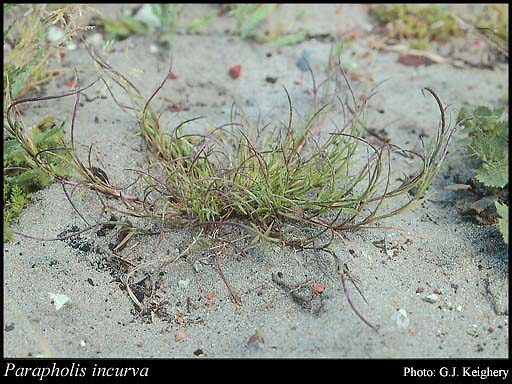- Reference
- Blumea Suppl.3:14 (1946)
- Conservation Code
- Not threatened
- Naturalised Status
- Alien to Western Australia
- Name Status
- Current
Annual, grass-like or herb, 0.3 m high. Fl. green, Sep to Dec. Grey sand, calcareous loam, often saline. Saline flats, salt lakes, saltmarshes, beach sandhills.

Distribution
- IBRA Regions
- Avon Wheatbelt, Coolgardie, Esperance Plains, Geraldton Sandplains, Hampton, Jarrah Forest, Mallee, Swan Coastal Plain, Warren, Yalgoo.
- IBRA Subregions
- Eastern Goldfield, Eastern Mallee, Edel, Fitzgerald, Geraldton Hills, Hampton, Katanning, Mardabilla, Merredin, Northern Jarrah Forest, Perth, Recherche, Southern Cross, Southern Jarrah Forest, Warren, Western Mallee.
- IMCRA Regions
- Abrolhos Islands, Central West Coast, Leeuwin-Naturaliste, WA South Coast.
- Local Government Areas (LGAs)
- Albany, Bassendean, Bruce Rock, Busselton, Carnamah, Chapman Valley, Cockburn, Coolgardie, Cunderdin, Dandaragan, Denmark, Dumbleyung, Dundas, Esperance, Goomalling, Greater Geraldton, Harvey, Kent, Kwinana, Lake Grace, Mandurah, Manjimup, Mingenew, Moora, Murray, Narrogin, Northam, Northampton, Nungarin, Plantagenet, Ravensthorpe, Rockingham, Shark Bay, Stirling, Swan, Tammin, Victoria Plains, West Arthur, Wickepin, Williams, Wongan-Ballidu, Woodanilling, Wyalkatchem, York.
Management Notes (for the Swan NRM Region)
Alternative Names. Curved sicklegrass, sickle grass.
General Biology. Growth form. Grass. Life form. Annual, caespitose. Reproduction. Seed. Dispersal. Water. Photosynthetic Pathway. C3.
Notes. Naturalised in the Americas, South Africa, India, New Zealand and southern Australia. Occurs on soils ranging from loams to clays in areas subject to seasonal flooding. Tolerant of high salinity levels and is a key coloniser of saline depressions. Has a short growing period, and matures rapidly after flowering and breaks up. Surface salinity can greatly affect the timing of seedling germination, with germination increasing substantially after salinity levels drop below a certain threshold. Will vary spatially and in abdundance between years depending on rainfall.
Additional information. Origin. Mediterranean coast and western Europe. History of use/introduction. Forage.
Management Calendar
| Calendar Type | Jan | Feb | Mar | Apr | May | Jun | Jul | Aug | Sep | Oct | Nov | Dec | Comments |
|---|---|---|---|---|---|---|---|---|---|---|---|---|---|
| Active Growth | Y | Y | Y | Y | Y | ||||||||
| Germination | O | Y | Y | ||||||||||
| Flowering | Y | Y | |||||||||||
| Fruiting | Y | Y | |||||||||||
| Optimum Treatment | Y | Y | Y |
Legend: Y = Yes, regularly, O = Occasionally, U = Uncertain, referred by others but not confirmed.
References
- Brown, K. & Brooks, K. (2002) Bushland Weeds: A Practical Guide to their Management. Environmental Weeds Action Network, Greenwood.
- Callaway, R.M. & Sabraw, C.S. (2000) Effects of variable precipitation on the structure and diversity of a California salt marsh community. Journal of Vegetation Science, 5 (3): 433 - 438.
- Department of Primary Industries (2009) Coast Barb-grass. State of Victoria URL: http://www.dpi.vic.gov.au/dpi/vro/vrosite.nsf/pages/water_sss_coast_barb_grass - Accessed January 2010.
- Hussey, B.M.J., Keighery, G.J., Dodd, J., Lloyd, S.G. & Cousens, R.D. (2007) Western Weeds. A guide to the weeds of Western Australia. 2nd Edition. The Plant Protection Society of Western Australia, Victoria Park.
- Noe, G.B. & Zedler, J.B. (2000) Differential effects of four abiotic factors on the germination of salt marsh annuals. American Journal of Botany, 87: 1679-1692.
- Noe, G.B. & Zedler, J.B. (2001) Spatio-temporal variation of salt marsh seedling establishment in relation to the abiotic and biotic environment. Journal of Vegetation Science, 12: 61-74.
- USDA, ARS, National Genetic Resources Program (2009) Germplasm Resources Information Network - (GRIN). National Germplasm Resources Laboratory, Beltsville, Maryland. URL: https://npgsweb.ars-grin.gov/gringlobal/taxon/taxonomysimple.aspx - Accessed October 2009.